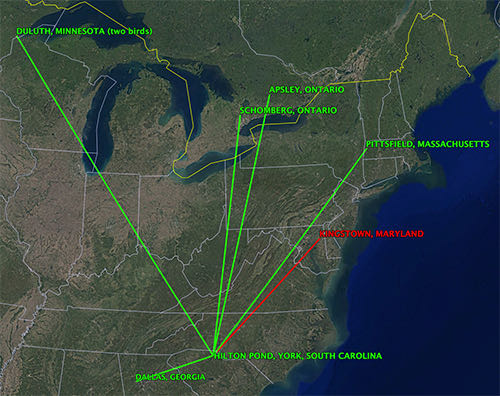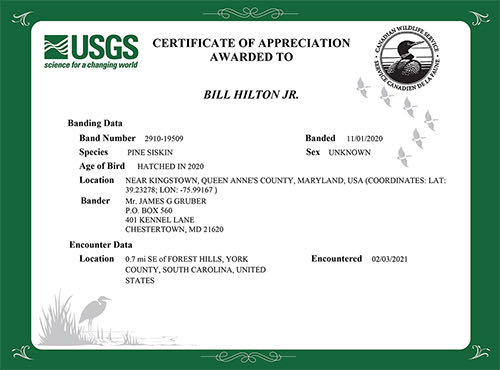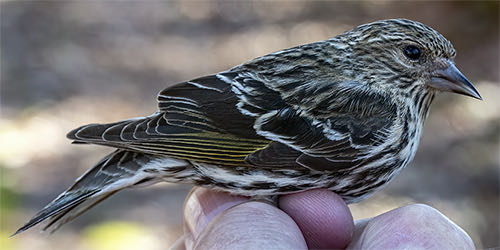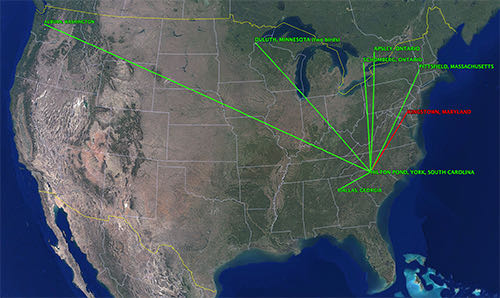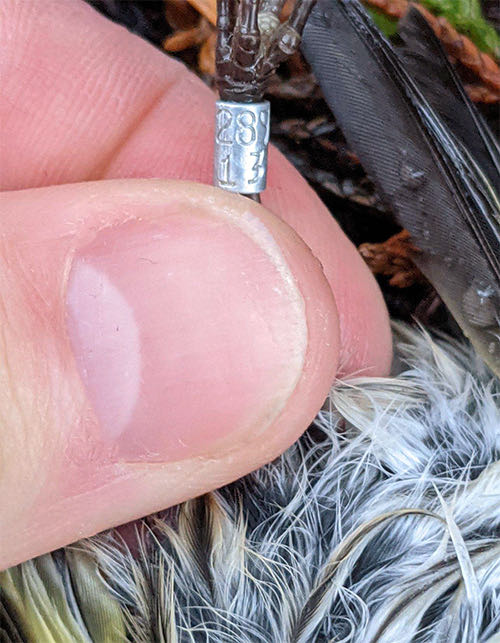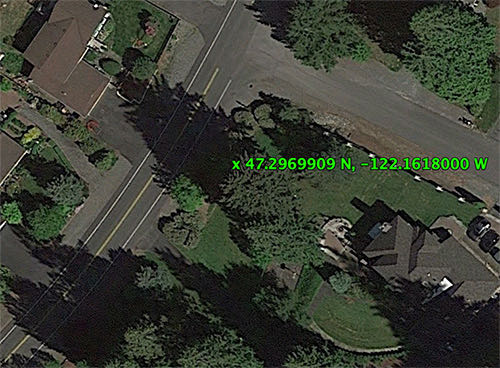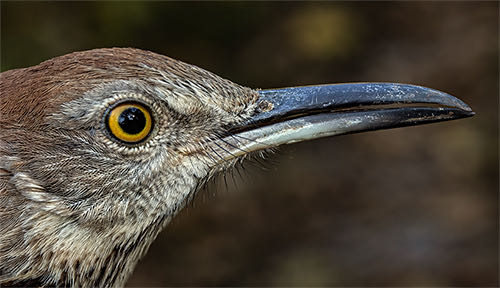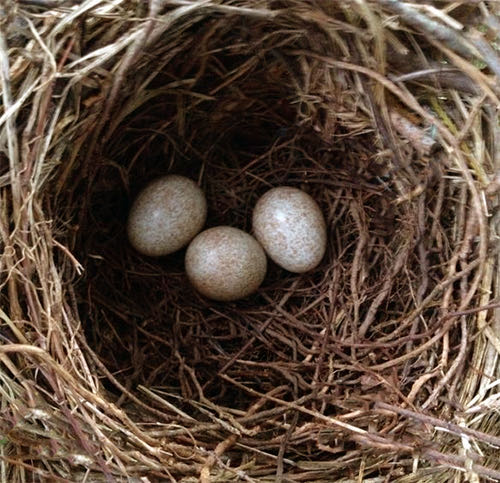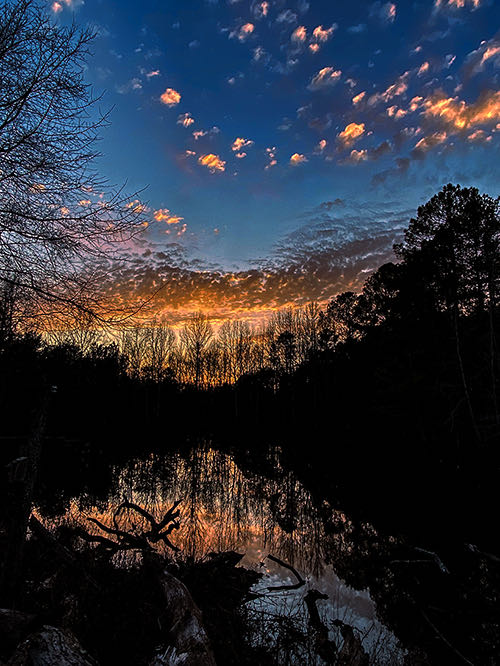- Established 1982 -HOME: www.hiltonpond.org
THIS WEEK at HILTON POND Subscribe for free to our award-winning nature newsletter (Back to Preceding Week; on to Next Week) |
All text, maps, charts & photos © Hilton Pond Center THE VALUE OF BIRD BANDING: The first snowfall of the season at Hilton Pond Center came on the night of 15-16 January 2022, barely coating the ground with less than two inches of white stuff. Exactly a week later--on the 22nd--we got a repeat, this time four inches (see sunrise photo, above) that did a better job of blanketing the landscape and making things look a bit more wintry. This time around our yearling Eastern Gray Squirrels--there's one at the base of the big Shagbark Hickory in the image above--knew better how to handle the weather; instead of holing up somewhere they were scampering about and digging through snow, apparently trying to remember where they'd buried that acorn last fall.
All text, maps, charts & photos © Hilton Pond Center Under these weather conditions our mist nets stayed tightly rolled shut but we did deploy a variety of traps. With snow covering many natural food sources, birds began flocking to the Center's feeders shortly after dawn; some entered traps baited with seed. First to arrive were Carolina Chickadees, Northern Cardinals, and White-throated Sparrows, followed in no particular order by American Goldfinches (above), Purple Finches, and House Finches--all species either recaptured or captured and banded at some point during the day.
All text, maps, charts & photos © Hilton Pond Center Unlike January 2021, however, there were no Pine Siskins (PISI, file photo above) to be seen at the feeders in 2022--snow or no snow. This time last year we were experiencing an unprecedented irruption of PISI, apparently driven east and south by failed tree seed crops across their Canadian and northwestern U.S. breeding grounds. We caught a LOT of siskins in the winter of 2020-21, ending with a total of 1,316 banded--nearly double the 780 captured in 2014-15 (our previous top winter for PISI). With that many Pine Siskins banded, we figured sooner or later some would be encountered elsewhere, When a finder reports a banded bird to the banding lab's automated Web site, basic information is usually available almost immediately: The bird's species and age, and when and where it was banded and by whom. Eventually, the researcher also gets a "Report to Bander" that describes when and where the bird was recaptured/recovered, along with the finder's contact information. Needless to say, receiving a "Report to Bander" can be the highlight of a bander's day--or even an entire research project--since such reports can help answer questions the bander might have had when the bird was banded in the first place. All text, maps, charts & photos © Hilton Pond Center Thanks to this cooperative mechanism, several Pine Siskins have indeed been encountered and reported outside our South Carolina home county of York after being banded at Hilton Pond Center, These encounters are shown on the map above and listed below in chronological order according to banding date. (All siskins were of unknown sex when banded.)
(Interestingly, the two Pine Siskins at Duluth were banded a year apart at Hilton Pond and recaptured an hour apart by bander Dennis Meyer. And we don't quite know what to make of the siskin that--after being banded in October at the Center--flew even further south into Georgia by the following March.)
All text, maps, charts & photos © Hilton Pond Center The bird in RED on the map above was a 2nd-year PISI (female, based on wing chord measurement) recaptured by us at the Center on 02/03/21. We duly reported her via the banding lab's Web site and received our Certificate of Appreciation (above) that revealed she had been been banded on 11/01/20 at Foreman's Branch Bird Observatory near Kingstown/Chestertown, MARYLAND (408 miles northeast).
All text, maps, charts & photos © Hilton Pond Center This is the only banded "foreign" siskin--that's her above--we have recaptured at Hilton Pond. However, it's quite interesting TWO American Goldfinches banded here were recaptured and released at that very same Foreman's Branch site! LONG-DISTANCE SISKIN All text, maps, charts & photos © Hilton Pond Center All the migratory Pine Siskin encounters just described were of scientific interest, especially the one from Foreman's Branch and the two that showed up "together" 990 miles away at Duluth. But then this month we got another "Report to Bander" (above) that just about knocked our crocs-flops off! All text, maps, charts & photos © Hilton Pond Center Lo and behold, another of our after-hatch-year Pine Siskins from Hilton Pond Center--this one banded on 26 March 2021 during last winter's irruption--was encountered on 20 December 2021 at (believe it or not!) Auburn, Washington, close to Seattle. This bird, the furthest-ever reported from the Center, required a full re-make of our PISI encounter map (above). Incredibly, the siskin was found 2,263 straight-line miles away from its South Carolina banding site! (And since birds don't usually fly in straight lines, we're certainly this continent-crossing Pine Siskin put on lots more wing miles than that!) The "Report to Bander" we received for this far-ranging Pine Siskin included the name and contact info for the finder, Dan Brewer, so we quickly e-mailed him for further details. He was kind enough to respond with documenting photographs, as follows:
All text, maps, charts & photos © Hilton Pond Center
All text, maps, charts & photos © Hilton Pond Center
We share Dan Brewer's astonishment over the East Coast-to-West Coast journey of this Pine Siskin and appreciate his family's efforts to report their finding and communicate further details to us at Hilton Pond. Since this bird was banded during last winter's big October-to-March influx and then found in Washington State in December 2021, we suspect it was much closer to its northwestern U.S. or Canadian breeding grounds this winter when an irruption and long-distance migration apparently did not occur. In any case, this well-traveled Pine Siskin must have been far from its permanent home when we first caught it, an amazing 2,263-mile cross-country distance for a little bird that weighed 12 grams--less than half an ounce! What a great story, one we know only because someone took time to report a band number from a bird they found. All text, maps, charts & photos © Hilton Pond Center LONG-LIVED THRASHER Bird banding is an invaluable, irreplaceable tool in our study of wild birds, especially in helping us understand migration in species such as those Pine Siskins described above. But banding also gives us the key to other major facets of bird biology we're not likely to understand without placing bands on birds' legs. One of these is site-fidelity, in which recapturing a bird at the same location in subsequent seasons or years confirms a bird's penchant to remain at (as a resident) or return to the same locale (as a migrant). In conjunction with site-fidelity, recaptures near or far also tell us about an individual bird's longevity and how long that bird's species might be expected to live in the wild. This, in turn, gives better knowledge of survivability, reproductive potential, and overall dynamics of bird populations. All these aspects of avian behavioral ecology were in play this week with the recapture of a grizzled Brown Thrasher (band #1152-11035) we had seen before at Hilton Pond Center.
All text, maps, charts & photos © Hilton Pond Center We banded this particular Brown Thrasher (BRTH; that's it above) as an adult (after-hatch-year) of unknown sex on 10 February 2014, meaning it must have hatched in 2013 or before. BRTH breed east of the Rockies and barely into southern Canada; southern populations are year-round residents that, in winter, may be joined by short-distance migrants from the northern half of the species' range. Since this week's thrasher was first captured in mid-winter there was no way to know whether it was resident or migrant--until we recaptured it six years later in mid-summer on 31 July 2020, suggesting year-round residency. Furthermore, at this recapture the thrasher had a featherless area on its belly that was edematous and vascularized; this "incubation patch" meant we finally knew its gender as female AND that she must be a local breeder. We re-trapped this ancient thrasher just this week on 26 January 2022 (and again three days later), meaning she is now an after-9th-year individual and the oldest of her species documented at Hilton Pond Center. (The Bird Banding Lab lists the oldest Brown Thrasher at 10 years 11 months; our bird is approaching that and--having been banded as after-hatch-year--could actually be even older than the record.)
All text, maps, charts & photos © Hilton Pond Center It's curious that despite all the Center's nets and traps we've caught this Brown Thrasher only four times in nine years. Perhaps she actually spends most of her time nearby but not on the property, or maybe she's especially wary of our capture devices. Regardless, she's apparently been around for eight breeding seasons, meaning she may have produced a LOT of baby thrashers. The species has 3-5 eggs per clutch (above) with likely double- and possibly even triple-brooding in a given year. A reasonable estimate suggests she and her mate(s) have blessed the neighborhood with at least four dozen fledglings during her reproductive life (to date). So there you have it, two intriguing stories of birds banded at Hilton Pond Center--a far-flying Pine Siskin and a geriatric stay-at-home Brown Thrasher. Everything of note we've learned about these two individuals--and many other local species--came about because the Bird Banding Laboratory allows for us in the name of science to place bands on birds' legs. We can hardly wait for that next "Report to Bander" to show up in the Center's e-mailbox! All text, maps, charts & photos © Hilton Pond Center HILTON POND SUNSETS "Never trust a person too lazy to get up for sunrise
All text, maps, charts & photos © Hilton Pond Center Sunset over Hilton Pond, 27 January 2022 They're all worth watching, but this was the best evening sky so far this year. Don't forget to scroll down for lists of all birds banded and recaptured during the period. Photoshop image post-processing for this page employs |
|---|
|
"This Week at Hilton Pond" is written and photographed by Dr. Bill Hilton Jr., executive director of Hilton Pond Center for Piedmont Natural History
|
|
|
Please refer "This Week at Hilton Pond" to others by clicking on this button: |
|

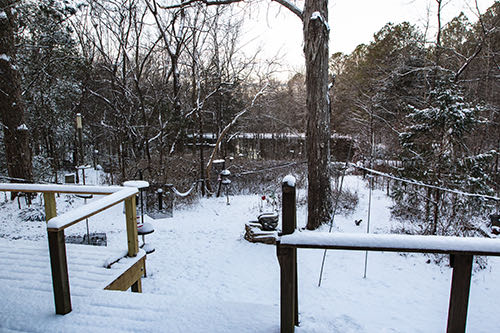
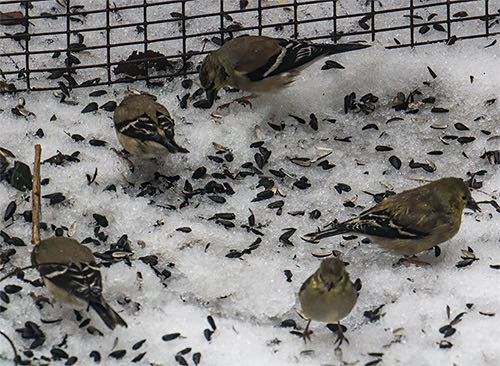
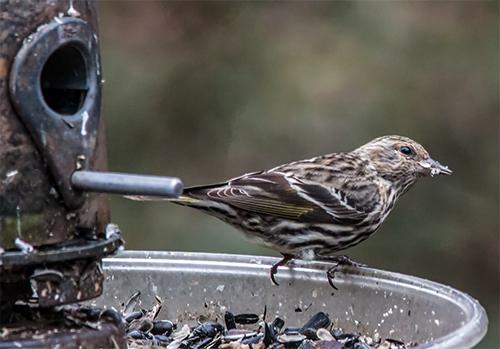
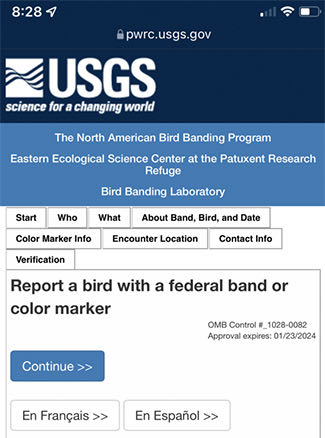 perhaps by a curious finder who was aware of the federal Bird Banding Laboratory
perhaps by a curious finder who was aware of the federal Bird Banding Laboratory 